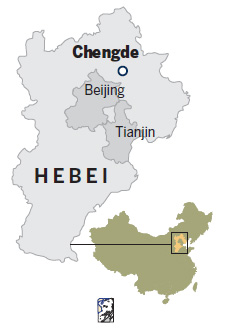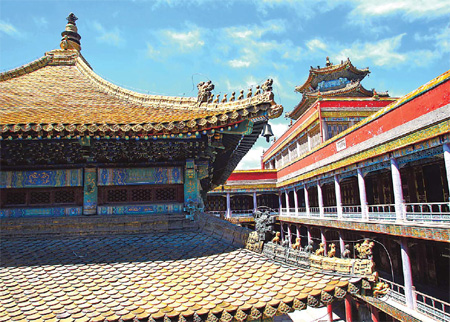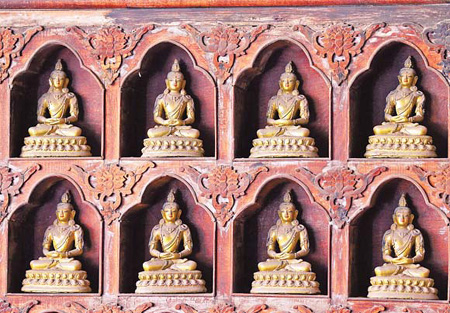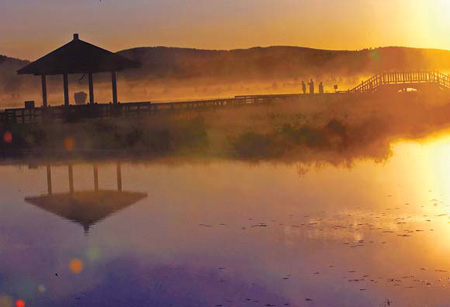|

Chengde Mountain Resort was a holiday retreat of China's last emperors. They avoided Beijing's stifling summer heat in palaces nestled in its cool, green hills. Xu Fan visits the resort and discovers its modern-day attractions.
Chengde is a small and picturesque city around two-hour's drive from Beijing. Here, Qing Dynasty (1644-1911) emperors built a summer palace as an imperial retreat for the rulers and their courts to flee the heat of summer every year. These days, it's a place where tourists, day-trippers and history buffs can get a taste of the imperial lifestyle and collect amusing anecdotes about these historic characters.
The resort was built by the Emperor Kangxi about 300 years ago. In those days, the royal court would have to make the one-week journey to Chengde using porters, sedans and horse-drawn carriages in a royal caravan known as luan jia. They would have envied the modern-day backpacker, who makes the trip in mere hours.
 |
| The gilt-roofed Wanfa Guiyi Palace in the World Cultural Heritage-listed Eight Outer Temples in Chengde, Hebei province. Photos by Zou Hong / China Daily |
These days, the 250-km distance from Beijing has been compressed to a two-hour expressway bus ride or around four hours by train. Soon, tourists will be able to look forward to an inter-city bullet train that will reduce the traveling time to just 40 minutes.
On the bus-ride to Chengde, I took out a guide book to review the history of this unique retreat. It was often called the "second capital", since some of the Qing emperors spent almost six months each year here.
It was once an unknown city lying in the northeast of Hebei province until it was picked as the place to escape the summer heat and a way of reducing the risks of smallpox, which the Manchurian rulers regarded as the worst plague.
Emperor Kangxi started the construction in 1703, but it took 89 years and the reign of three emperors for the grand project to finish. The finished retreat spanned 5.64 million square meters and included three sections: mountain, lake and the plains.
Most visitors attracted to Chengde by its reputation may expect to escape the hustle and bustle of the big cities. They may be disappointed because the place is always packed with local and foreign sight-seers in the peak season.
On the Internet, veteran visitors have jokingly posted: You don't need to hire a guide at Chengde. Everywhere you go, there'll be guides speaking into microphones, followed by groups of tourists wearing identical caps printed with the travel agencies' names.
The best way to enjoy the ancient architectural complex is to stay in hotels near or in the resort. It may cost you more but the convenience is worth the expenditure.
If possible, go to Chengde in the autumn, when the tourist season is already petering off but the natural beauty of the attractions is still untarnished by the winter frosts.
When sun slips down the mountains and the tourists go home, the royal retreat recovers its peace and tranquility. This is the best time to relax and look back at the resort's history.
A half-open bright red palace door, a tree-lined avenue twisting and turning in the garden and a string of wind chimes swaying from the eaves - they all inspire a look into the past.
Compared to the quiet nights, the busy, noisy days at the Puning Temple and Putuo Zongcheng Temple have a different charm.
At the temples, it's common to see thousands of devotees spin prayer wheels or mutter scriptures under their breath with all their hopes and aspirations on their faces.
Puning Temple was built by the Emperor Qianlong, the grandson of Kangxi. It was modeled after the Samye Monastery, a sacred Lama site in the Tibet autonomous region. Putuo Zongcheng Temple, more popularly known as little Potala Palace, is a smaller replica of the famous Tibetan complex.
Both Tibetan-style temples are now part of the World Cultural Heritage-listed Eight Outer Temples built by the Manchu court to welcome and accommodate leaders of religious and ethnic groups.
In the past, only high officials and nobles were allowed to enter the royal temples and the resort. These days, the entrance criteria are more democratic and plenty of visitors in sunglasses and T-shirts wander the grounds in a right royal way.
While I was climbing up the steep steps leading up to the 43-meter-high platform in Putuo Zuocheng Temple, I passed a French tourist in a wooden sedan chair carried by two strong local bearers. She smiled happily and told me it cost her just 80 yuan ($11.8) for the round trip up and down.
Not too far away at the base of the steps, a little booth displayed a whole wardrobe of Qing Dynasty costumes. For 10 yuan, you can dress up and take a picture.
A young lady chose a Manchurian princess' red outfit and put on a matching headdress. When she elegantly strolled in the grounds of the 300-year-old palace, it seemed time had warped and we were back in history.
Once you have successfully navigated the steps up, there is the gilt-roofed Wanfa Guiyi Palace. Tourist guides often tell this story: When the invading Japanese army wanted to scrape away the gold from the roof, two soldiers mysteriously toppled off to their deaths. The attempt stopped.
Some of the resort's memories are dark and painful, but the natural beauty of the scenic Bashang Grassland can provide some relief.
It is a three-hour bus ride from Chengde, and when we arrived it was near evening. The cloud-studded twilight sky and the soft fading light created a spectacular view of the prairie.
But, local residents say the most beautiful time to see the grasslands is early morning, so after a warm bonfire party that night, we went to bed and set the alarm for 4 am.
The early bird catches the worm, they say. In our case, we had booked the hotel's only rental car and our party of four were heading off while most of the other visitors were still tucked up in bed. Our destination was the Seven Stars Lake, a wetland park named after the constellation, the Big Dipper.
It was an unforgettable wonderland. Thin veils of early morning fog floated on the large lake, which was surrounded by vast areas of verdant grass. A couple of slowly-turning windmills and a long wooden walkway slowly appeared as the mist lifted.
My guide book says Kangxi, who loved hunting in the grasslands, was initially attracted by this same landscape and was so inspired that he decided he wanted his summer resort built nearby. It was thus a fitting place to end our journey - in his imperial footsteps.
 |
| Buddha statues in the Eight Outer Temples in Chengde. |
 |
| The Seven Stars Lake looks like a fairyland in the early morning mist. |
By Xu Fan (China Daily)
|